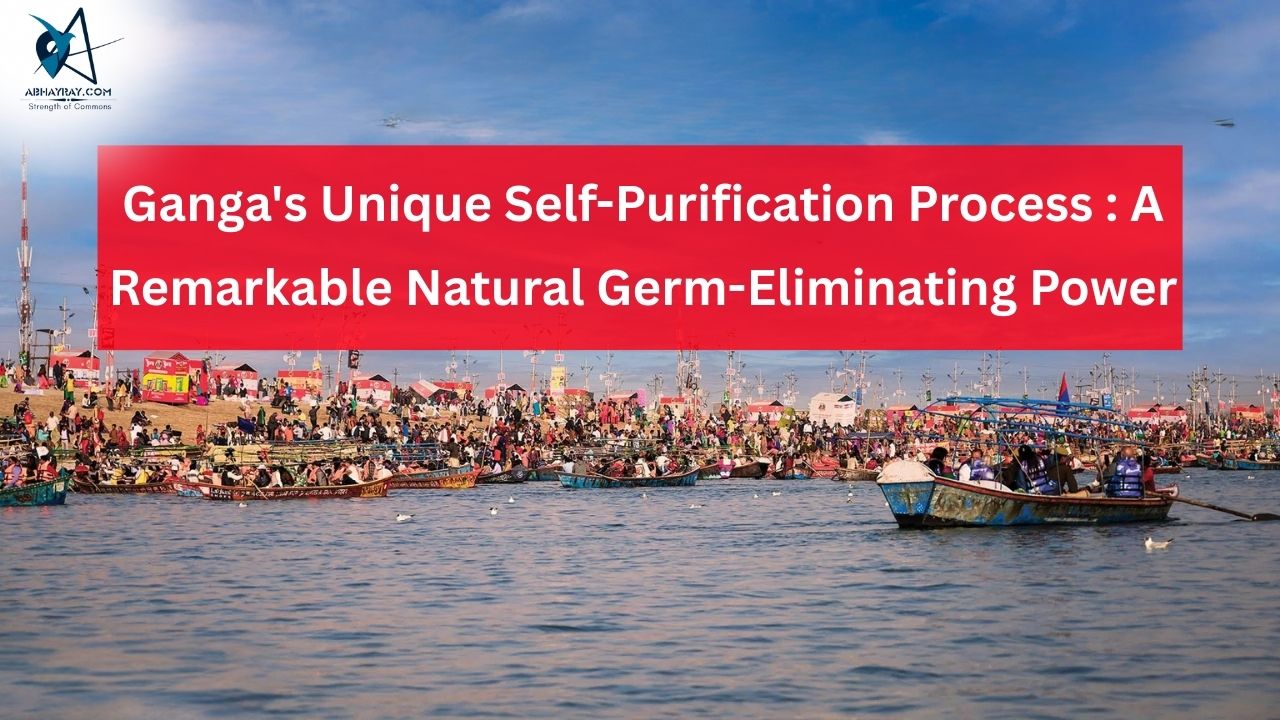Introduction
The Ganga River, one of the holiest rivers in India, is renowned not only for its cultural and spiritual significance but also for a remarkable scientific feature: its self-purification ability. Despite the millions of devotees who bathe in its waters during religious events like the Maha Kumbh, the Ganga maintains its purity due to a natural system powered by bacteriophages—microscopic viruses that target and eliminate harmful bacteria. According to research conducted by Dr. Ajay Sonkar, a prominent figure in cancer research and cell biology, the Ganga is the only freshwater river in the world with such a unique natural purification mechanism.
Unique Self-Purification Mechanism of the Ganga
The Ganga’s ability to purify itself is primarily attributed to bacteriophages. These viruses, which are naturally abundant in the river, are capable of targeting and destroying harmful bacteria by injecting their genetic material into the bacterial cells, ultimately killing them. What makes the Ganga’s purification process particularly extraordinary is that these bacteriophages work 50 times faster than typical bacteriophages in other environments, effectively neutralizing microbial contaminants at an accelerated rate.
Bacteriophages perform a selective cleansing process by targeting only harmful bacteria, thus preserving beneficial microorganisms that are vital for maintaining the ecological balance of the river. This selective action ensures that the Ganga remains clean while also safeguarding the river’s biodiversity.A key feature of this natural purification system is the rapid reproduction of bacteriophages. Each bacteriophage can reproduce between 100 to 300 new phages in each cycle, ensuring a continuous cycle of bacterial elimination. This ability to reproduce quickly makes the self-purification process sustainable over time, allowing the river to remain remarkably free from harmful bacteria despite the constant influx of people during religious events.
The Role of Bacteriophages in Ganga’s Purification
Bacteriophages play a vital role in the Ganga’s purification process, particularly during large religious gatherings like the Maha Kumbh, when millions of people bathe in its waters. Despite the vast amount of human activity, the bacteriophages are able to neutralize the harmful germs released by the devotees, ensuring the water remains clean and safe.
One of the most fascinating aspects of this purification process is how bacteriophages selectively eliminate harmful bacteria while leaving beneficial microorganisms intact. This means that while the Ganga may be subjected to significant contamination due to human activities, the bacteriophages are able to specifically target and destroy the harmful pathogens, without disrupting the overall microbial ecosystem that supports the river’s health. The self-purification mechanism of the Ganga is reminiscent of oceanic purification processes, where natural microbial interactions help maintain water quality. The bacteriophages in the Ganga effectively mimic this process by performing rapid and efficient cleansing, making the river a unique example of nature’s ability to maintain its own water quality without external interventions.
What Are Bacteriophages?
Bacteriophages, often referred to as “bacteria eaters,” are viruses that specifically target and infect bacteria. These viruses are abundant in nature and are found in nearly every environment where bacteria thrive. Bacteriophages consist of genetic material enclosed within a protein shell, and their primary function is to infect bacteria by injecting their genetic material into bacterial cells. Once inside the bacteria, the bacteriophage hijacks the cell’s machinery to reproduce more phages, eventually causing the bacteria to burst and die.
Bacteriophages are critical players in ecosystems, as they help regulate bacterial populations, facilitate genetic exchange among bacteria, and influence bacterial evolution. Their presence in the Ganga River plays a central role in maintaining the river’s water purity and ecological balance.
Scientific Validation and Expert Insights
Dr. Ajay Sonkar’s groundbreaking research into the Ganga’s self-purification system has provided scientific validation for the river’s remarkable water quality. Dr. Sonkar, who is recognized for his expertise in cancer research, genetics, and cell biology, has collaborated with prominent institutions like Wageningen University, Rice University, the Tokyo Institute of Technology, and Harvard Medical School to further support the findings regarding the Ganga’s unique properties.
In his research, Dr. Sonkar emphasizes the importance of the Ganga’s self-purification mechanism as a natural marvel that should inspire humans to coexist with nature. He believes that just as the Ganga has maintained its purity through natural processes, humanity must learn to live sustainably and in harmony with the environment.Additionally, studies have shown that the alkaline nature of Ganga water plays a crucial role in supporting the survival of bacteriophages, further enhancing the river’s ability to purify itself.
Significance of the River Ganga
The Ganga holds deep cultural, religious, and economic value. Revered as a goddess by millions of Hindus, the river is central to religious rituals and spirituality. It also serves as a crucial lifeline for millions of people who rely on its waters for drinking, farming, and other daily activities.Economically, the Ganga supports significant tourism, particularly during major events like the Maha Kumbh. These events not only attract millions of devotees but also contribute substantially to India’s economy, with estimates suggesting that the Maha Kumbh alone generates around ₹3 lakh crore in economic activity.
From an environmental perspective, the Ganga’s ability to naturally cleanse itself serves as an important lesson for sustainable water management practices. The river’s unique purification process highlights the potential for natural systems to maintain water quality and offers a valuable model for other regions facing challenges with water pollution.
Government Response and CPCB Concerns
The Central Pollution Control Board (CPCB) has raised concerns over the water quality of the Ganga, particularly during large religious events. However, in response to these concerns, the Uttar Pradesh government has cited Dr. Sonkar’s research to assert that the river’s water remains pure and alkaline, despite the large influx of devotees during the Maha Kumbh. The government’s statement supports the findings that the Ganga’s natural self-purification system continues to function effectively, ensuring the river’s water remains clean even under high-pressure conditions.
Conclusion
The Ganga River’s extraordinary self-purification ability, driven by bacteriophages, sets it apart as a unique natural phenomenon. Despite intense human activity, particularly during events like the Maha Kumbh, the river maintains its purity by rapidly eliminating harmful bacteria without disrupting its ecological balance. Validated by Dr. Ajay Sonkar’s research and supported by international collaborations, this natural cleansing system offers a powerful example of nature’s resilience and intelligence. Beyond its spiritual and cultural significance, the Ganga serves as a model for sustainable water management, inspiring efforts to protect and harness nature’s own solutions for environmental challenges.
GMICapitals.com RaysVeda.com GetMyStartup.com LawCanal.com GetMyIndia.com ZinCob.com Angeltors.com

